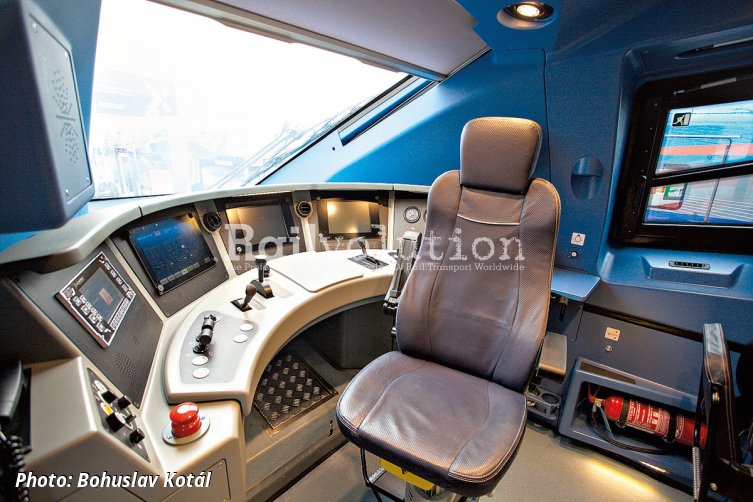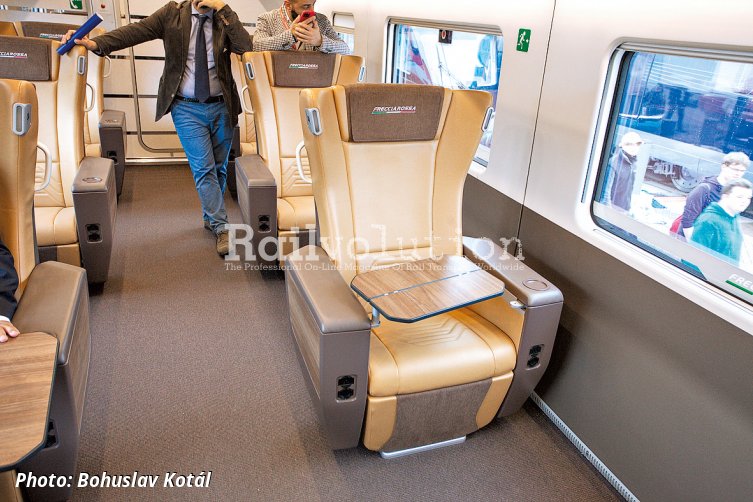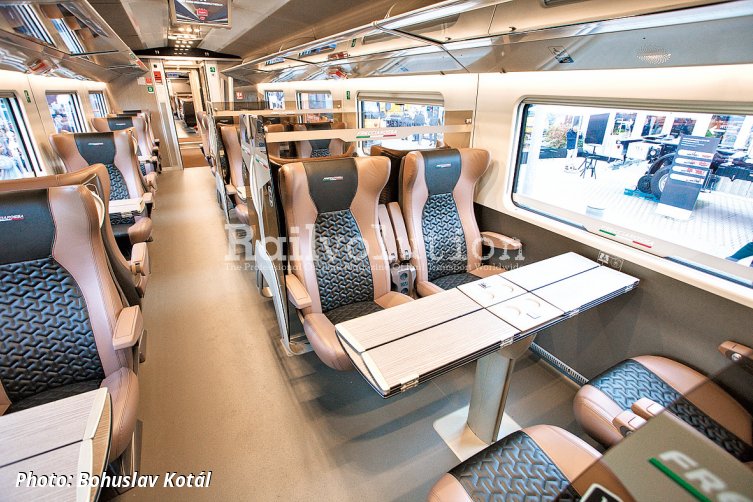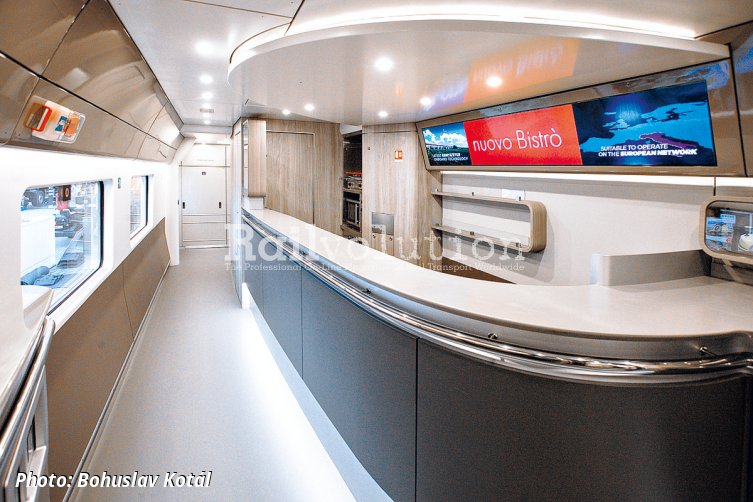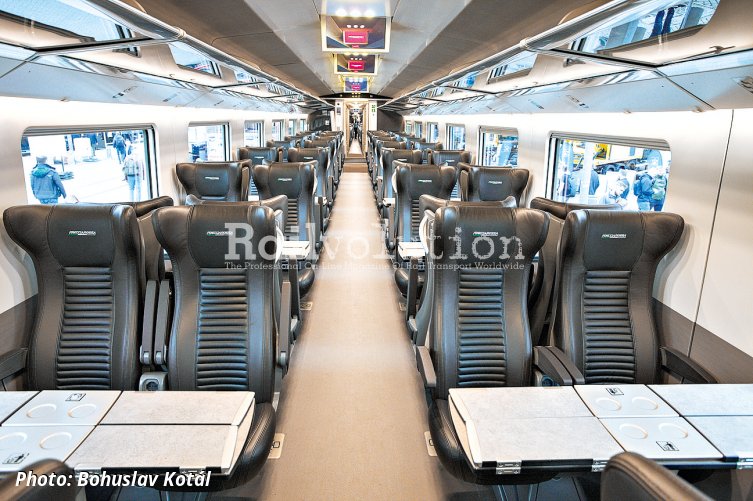InnoTrans 2024 report (26)
posted on 27th Mar 2025 11:02
Hitachi Rail on InnoTrans 2024 introduced the Frecciarossa 1000 unit (ETR 400 series according to the Italian scheme), specifically four cars from the Trenitalia’s ETR 400 061. This is the second presence of this type at InnoTrans, as the first time the ETR 400 series (unit 005) was on display in September 2014, shortly before the start of operations in June 2015. This time, after ten years, it was an upgraded version of Frecciarossa 1000. Trenitalia is still expanding its fleet of these interoperable eight-car high-speed trains:
- first, in 2010, it ordered 50 units, which were designated ETR 400 001 - 050,
- then, in 2019, an order was placed for a further 14 trains - inventory numbers ETR 400 051 - 064
- followed by a contract for 36 trains with an option for 10 more on 10 November 2023.
The original Frecciarossa 1000
The original series of "Red Arrows", designed by the Italian studio Bertone, was constructed by a consortium of Bombardier Transportation (chassis, drives) and AnsaldoBreda (car bodies, interiors, train control) as the type V300 ZEFIRO. However, in 2015, the Italian manufacturer Ansaldo-Breda was sold off by its owner, Finmeccanica, to the Japanese group Hitachi Rail and became Hitachi Rail Italy, which coincidentally took place the same year that the first ETR 400 units started passenger service.
A few years later, Bombardier Transportation had met a similar fate, as it was acquired by Alstom in 2021. The latter announced in December of that year that, as part of its commitments to the European Commission in this transaction, it had agreed with Hitachi Rail to transfer BT's commercial activities in the V300 ZEFIRO project, assuming the obligation to complete on BT's behalf the orders for 1000 Frecciarossa trains for Trenitalia at the time and a further 23 for ILSA (now Iryo), operating in Spain.
Adding up the above orders, Trenitalia now has a total of 100 trains on order; and in case the option from the last contract is confirmed, this figure rises to 110. However, the second of the above-mentioned orders has been divided into two, where the production of ETR 400 051 - 058 ran until 2022 and with ETR 400 059 Hitachi began manufacture the upgraded version. Member of this version, ETR 400 061, was demonstrated in Berlin last year.
The upgraded train
The new version of Frecciarossa 1000 has upgraded control electronics and drives, uses power elements from Hitachi, and production is no longer dependent on subcontracting from Alstom. Attention has been paid to increasing the energy efficiency of the traction drive, but also of the whole train. There also is newly designed LED lighting and air-conditioning units with more environmentally friendly refrigerant. The interior has been redesigned, both the colour scheme and the layout. Four seats have been added in the Executive class, while the conference area has been removed. The Business class has been slightly redesigned.
Eight large luggage racks were added in Standard class, while the number of seats was kept the same, and the overhead luggage racks were also enlarged; this class is found in the four remaining cars that were not on display in Berlin. The bistro has undergone modifications rather on the service side, as the space for food preparation has been increased and the space for storing catering trolleys has been maximised. The on-board WiFi now uses 5G modems for internet connectivity. Braille has been added to the signage in the cars. The focus on sustainability has also been increased: 97.1% of the materials used to build the train are now recyclable (a 2.7% increase on the original design).
The technical description
The Frecciarossa 1000 is designed for a top operating speed of 360 km/h, with a maximum design speed of 400 km/h. The axle arrangement is Bo'Bo' + 2'2' + Bo'Bo' + 2'2' + 2'2' + Bo'Bo' + 2'2' + Bo'Bo'. The wheelbase of the bogies is 2 850 mm. The length of the train is 202 m, the width of the bodyshells 2 924 mm and the height of the cars 4 080 mm above TOR. The car bodyshells are welded from aluminium alloy profiles, the boarding doors are 900 mm wide. The unit has a service weight of 500 t. There are 455 seats, of which 14 are in Executive, 69 in Business, 76 in Premium and 300 in Standard class. There are 14 toilets on the train, including one wheelchair accessible and one for staff.
Traction equipment installed is for traction systems 1,5 kV DC, 3 kV DC, 15 kV 16,7 Hz and 25 kV 50 Hz. The traction inverters, 16 in all, i.e. one for each traction motor, use semiconductor IGBT elements and are liquid cooled. The power of the train on the 25 kV system is 9 800 kW, on the 15 kV system it is reduced to 6 900 kW and on the DC systems it is adequately lower, the starting acceleration is 0,7 m/s2. The units are also prepared for service in France, Germany, Spain, Austria, Switzerland, the Netherlands and Belgium, where they are to be approved in a phased manner. The ETCS Level 2 is installed, as well as some national ATPs such as LZB (Germany), ASFA (Spain), SCMT (Italy).
The upgraded version is referred to by the manufacturer as ETR 1000. The use of the series designation ETR 410 is also being considered, as it is after all a certain design development, but the EVNs of the upgraded units completed so far correspond to the existing series designation, e.g. 93 83 3400 161.
Testing and approving the new version
The new version of the Red Arrows is currently undergoing the approval process. A significant part of the testing is taking place at the VUZ Velim, where the first unit of the new sub-series, ETR 400 059, arrived last June and the second, ETR 400 060, in August. The high-speed trials on the Italian network started with two units in December 2024 and are expected to be completed in March 2025. As of February this year, Hitachi has produced three more units, which will take part in the trials in turn. They have turned production over to the November 2023 order for 36 units, of which three more sets are in various stages of production and are scheduled for completion this year.
Type approval and handover of the first upgraded Frecciarossa 1000 units to the customer is expected during 2025. Deliveries are scheduled until 2028 at a rate of approximately eight trains per year. Further trains are being acquired to expand Trenitalia's operations to other European countries, which, moreover, the carrier has announced since the first order and is now characterised by "the possibility of operating on seven European corridors". In December 2021, the ETR 400 units began regular services to Paris. The same high-speed trains, but as 109 series according to the Spanish scheme, have been operated in Spain since March 2023 by the open access carrier Iryo, in which Trenitalia is a shareholder. And current plans speak, for example, of a detour to Germany.
Trenitalia's expansion plans are also responded to by the contract signed by HÜBNER and Hitachi Rail at the beginning of February 2025, for the supply of up to 280 gangways for Frecciarossa 1000 units. These have been fitted with HÜBNER systems from the outset; these gangways are characterised by pressure-tight bellows that mould to the contour of the vehicle, thereby significantly reducing air resistance.
This order covers up to 40 units (seven crossings per train) for up to 280 units, and the press release in question states that the new ETR 1000 units are intended not only for the Italian high-speed network but also for VRT throughout Europe. Deliveries of these gangways are scheduled for 2025-29, which exceeds the aforementioned 2028 year set for deliveries of ETR 400 100 units, so this should cover the 10 train option.



